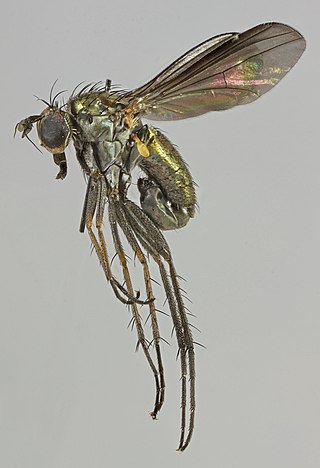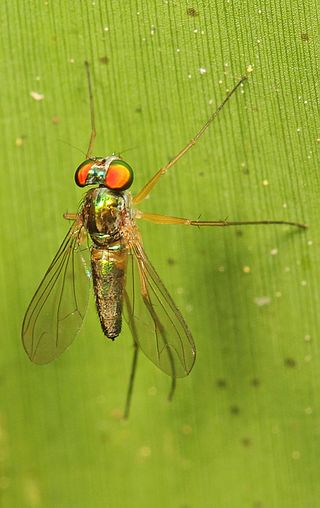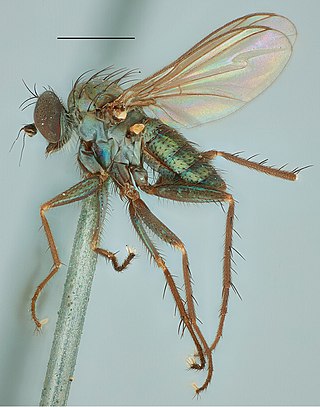
Hercostomus is a genus of flies in the family Dolichopodidae. It is a large genus, containing more than 483 species worldwide. Multiple studies have shown that Hercostomus is a polyphyletic assemblage of species.

Amblypsilopus is a genus of flies in the family Dolichopodidae. It is a large genus, with about 350 species recorded. However, it is possibly polyphyletic.

Asyndetus is a genus of flies in the family Dolichopodidae. There are more than 100 species described for the genus, distributed worldwide.
Chaetogonopteron is a genus of flies in the family Dolichopodidae.

Chrysosoma is a genus of flies in the family Dolichopodidae. It is a large genus, with more than 200 species distributed in the Old World and Oceania.

Medetera is a large genus of flies in the family Dolichopodidae. It includes about 350 species worldwide. The adults are commonly found resting on vertical surfaces such as tree trunks, on which they have a characteristic vertical upright stance. Because of this stance, they are sometimes known as "woodpecker flies". Medetera adults are predators of soft-bodied arthropods, while the larvae are predators of bark beetle larvae.
Nepalomyia is a genus of flies in the family Dolichopodidae.
Plagiozopelma is a genus of flies in the family Dolichopodidae.

Rhaphium is a genus of flies in the family Dolichopodidae. It is the largest genus within the subfamily Rhaphiinae, with over 200 species currently known.

Sybistroma is a genus of flies in the family Dolichopodidae. It includes over 50 species, described mainly from the Palaearctic and Oriental realms. A single species is known from the Afrotropical realm. Until 2005, the genus was thought to be restricted to the Mediterranean in distribution, with five known species. It was recently expanded to include the former genera Hypophyllus, Ludovicius and Nodicornis, as well as some species of Hercostomus.

Syntormon is a genus of flies in the family Dolichopodidae. It includes about 110 species worldwide, more than 50 of which were described from the Palaearctic realm.
Telmaturgus is a genus of flies in the family Dolichopodidae. It has a cosmopolitan distribution.

Dolichopodinae is a subfamily of flies in the family Dolichopodidae.

Medeterinae is a subfamily of flies in the family Dolichopodidae.

Peloropeodinae is a subfamily of flies in the family Dolichopodidae. In some classifications, the genera of the subfamily are included in Sympycninae. According to a molecular phylogenetic analysis of the family Dolichopodidae by Germann et al. (2011), the subfamily is polyphyletic.
Parahercostomus is a genus of flies in the family Dolichopodidae. It includes four species known only from China. Members of the genus are metallic green in color and large in size, with a body length of 4.5–5.3 mm and a wing length of 5.2–7.0 mm. The generic name is a combination of the prefix para- with the generic name Hercostomus. According to Brooks (2005)'s phylogenetic analysis of the subfamily Dolichopodinae, Parahercostomus appears to be closely related to Grichanov (1999)'s Afrotropical species group 1 in the genus Hercostomus, which was later transferred to the genus Afrohercostomus.
Pseudargyrochlamys is a genus of flies in the family Dolichopodidae. It was first established by Igor Grichanov in 2006 for four species of Paracleius from eastern South Africa. A fifth species from South Africa was described in 2020. Members of the genus are restricted to the coast of southern Africa between East London in South Africa and Maputo in Mozambique. The genus is closely related to Argyrochlamys and Phoomyia, which are also found in coastal habitats.
Setihercostomus is a genus of flies in the family Dolichopodidae, known from China, Taiwan, Russia and Tanzania.











